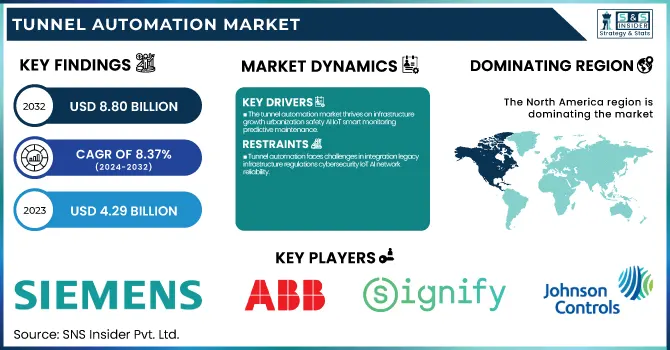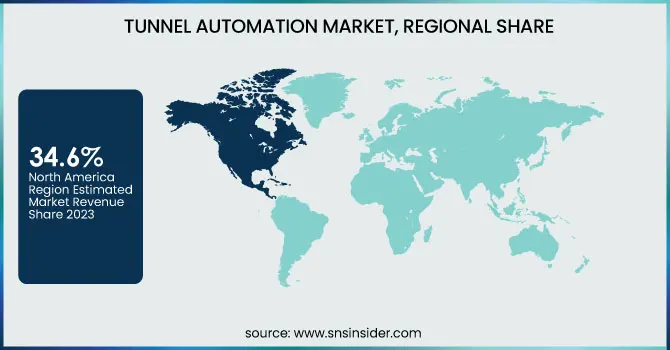Tunnel Automation Market Size & Growth:
The Tunnel Automation Market Size was valued at USD 4.29 billion in 2023 and is expected to reach USD 8.80 billion by 2032, growing at a CAGR of 8.37% over the forecast period 2024-2032. The United States has proactively been improving its tunnel systems, too, implementing modern automated systems to improve either safety or operations. Plants Automation Systems to satisfy on-time performance of key components including HVAC, lighting, power supply, and signalization systems.

To Get more information on Tunnel Automation Market - Request Free Sample Report
Modernizing this will fit with the national effort to upgrade its aging transportation infrastructures tunnels for roadways, railways, underground trains, and growing safety concerns, and to better regulate traffic. With the further incorporation of IoT and cloud-based technologies, our monitored infrastructure will be real-time and controllable, a huge paradigm shift in the U.S.
The U.S. Tunnel Automation Market is estimated to be USD 1.06 Billion in 2023 and is projected to grow at a CAGR of 8.10%. Improvements in infrastructure and implementation of safety regulations are driving the growth of the tunnel automation industry in the U.S. Real-time control and monitoring to make tunnel operation efficient with the adoption of IoT, AI, and cloud-based monitoring.
Tunnel Automation Market Dynamics
Key Drivers:
-
The tunnel automation market thrives on infrastructure growth urbanization safety AI IoT smart monitoring predictive maintenance.
Tunnel automation market growth is primarily driven by rising infrastructure investments, urbanization, and a need for more safety in tunnels. So, all the governments across the world are working towards the modernization of their tunnel systems to avoid accidents and better traffic circulation as well as better ventilation and keeping water outside before entering the tunnel. Increasing IoT adoption, AI-based monitoring, and cloud-based automation will keep the demand landscape lucrative in upcoming years, as they facilitate real-time traffic management and predictive maintenance. Also, the authorities have stringent safety regulations like NFPA 502 for road tunnels and the EU Tunnel Safety Directive and hence are upgrading lots of existing tunnels with automatic lighting, HVAC, and fire detection systems. Automation demand is also accelerating with the expansion of high-speed rail networks and smart city projects.
Restrain:
-
Tunnel automation faces challenges in integration legacy infrastructure regulations cybersecurity IoT AI network reliability.
A key factor hampering the growth of the tunnel automation market is system integration challenges. Because many tunnels (especially those in developing regions) were designed before current trends toward automation, bringing such new capabilities as IoT-based monitoring, AI-based traffic management, and cloud-based control systems into the mix can be a challenge. Furthermore, the absence of uniform regulations across regions poses challenges for manufacturers and service providers, given the significant differences in compliance needs. Another risk, which comes as a consequence of tunnel systems being automated and relying on interconnected networks, is related to cybersecurity. These networks could be hacked, and systems could even fail, leading to a shutdown of operations.
Opportunity:
-
Tunnel automation thrives with 5G AI sensors digital twins smart grids metro projects renewable energy expansion.
Tunnel automation is one area that could greatly benefit from advances in sensor technology and 5G connectivity as well as the increasing availability of AI-powered analytics. Digital twin technology enables operators to monitor and maintain physical assets with virtual models in real time, minimizing downtime and operational costs. Tunnel projects such as metro and highway are being planned extensively by emerging economies especially in Asia-Pacific and the Middle East thereby creating relatively profitable opportunities for automation providers. The recent integration of various renewable energy solutions such as solar lights and smart grids is also gaining traction which drives automation technology companies to explore wider and more lucrative revenue streams in tunnel operations.
Challenges:
-
Tunnel automation faces challenges in skilled workforce environmental disruptions interoperability AI predictive maintenance reliability.
The technical know-how for operating and maintaining advanced tunnel automation systems is another important challenge. As AI-driven monitoring systems, predictive maintenance tools, and real-time data analytics become ubiquitous across industries, endemic shortages in skilled professionals capable of managing these technologies plague many regions, resulting in operational inefficiencies. In addition to that, uncontrollable environmental conditions can interrupt automatic operations like excessive weather situations, seismic activity, and floods, therefore robust and adaptive responses are needed. Further, seamless interoperability of automation components such as HVAC automation, lighting automation, fire safety, and signalization systems is an ongoing challenge due to the different protocols and technologies used by different vendors, resulting in compatibility issues.
Tunnel Automation Market Segment Analysis
By Offering
Hardware held the largest market share of 50.8% in the tunnel automation market in 2023. This was owing to the large-scale deployment of sensors, controllers, lighting systems, HVAC equipment, and fire safety solutions. Tunnel infrastructure is being modernized with state-of-the-art automated surveillance equipment, ventilation systems, and communication systems to enhance safety and operational capabilities, requiring increasing investments from governments and private organizations. The use of cutting-edge signalization and power supply systems also increased hardware deployment.
During the forecast period, from 2024 to 2032, the software is projected to exhibit the highest CAGR, propelled by the rising adoption of AI-enabled monitoring cloud-based traffic management, and predictive maintenance solutions. The applications of IoT and the digital twin of the tunnel are to realize real-time monitoring and controlling to enhance the efficiency of the tunnel operation and reduce downtime Moreover, the increasing requirement for cybersecurity solutions to safeguard automated tunnel systems from cyber threats is propelling the software-based solution adoption in transportation infrastructure across the globe.
By Tunnel Type
The railway segment accounted for the largest share of 59% in 2023 and is projected to see the highest CAGR from 2024 to 2032. Demand for Tunnel Automation Solutions is driven by the increasing expansion of high-speed rail networks, metro, and underground transport projects. Regulations imposed by governments across regions, especially in Europe, Asia-Pacific, and North America to improve connectivity through railway tunnels and reduce congestion, are expected to positively influence the global market. Railway drift automation comprises AI-based checking, mist blowing, live signalization, and cloud control systems, sustaining safety and operational performance in tunnels. Use of IoT sensors and predictive maintenance software to avoid downtime and optimize train schedules. Moreover, the increasing adoption of tunnel automation owing to be driven shortly by factors such as strict railway safety regulations and the demand for smart infrastructure development, is expected to drive growth which makes the railway segment the most lucrative segment in terms of tunnel automation for the coming years.
By Component
The HVAC accounted for 34.7% of the share of the market in 2023 due to the growing demand for proper ventilation, air quality management, and temperature control of tunnel systems. With rising concerns about air pollution, fire safety, and passenger comfort, the operators of tunnels are scaling up the investments made in heating, ventilation, and air conditioning (HVAC) systems. They are vital in facilitating air circulation, eliminating fumes, and ensuring the safety of passengers and employees. This is promoting more growth of the market with energy-efficient automated HVAC solutions.
Signalization is expected to grow at the fastest CAGR from 2024-2032, driven by the increasing need for AI-enabled traffic control and live monitoring solutions. The tunnel safety and efficiency can be improved, which reduces accidents and ensures a large transportation pattern through automated signaling, communication, and control technologies. The adoption is further driven by the integration of IoT-based smart signalization systems, which allows better coordination with road and rail tunnels.
Tunnel Automation Market Regional Outlook
In 2023, North America held the largest segment of the market with a share of 34.6% due to high investments in tunnel infrastructure modernization and automation. The U.S. & Canada are leading the way in using AI-powered monitoring systems, IoT-integrated Ventilation, and automated lighting solutions to help tunnels more secure & efficient. One of the biggest is that of the Alaskan Way Viaduct Replacement Tunnel in Seattle, which has had automated fire suppression, advanced HVAC, and smart surveillance systems for real-time monitoring. The Detroit-Windsor Tunnel, which links the U.S. and Canada, has also recently received a fair amount of automation upgrades, including automated toll collection, air quality sensors, and Emergency Response Solutions, all to help make things operate a little more efficiently.
Europe is expected to see the fastest compound annual growth rate from 2024-2032, driven by rising smart tunnel projects investment coupled with rigorous safety regulations. The region is rolling out AI-based traffic management systems, predictive maintenance software, and digital twin technology for better tunnel performance. One such example is the Gotthard Base Tunnel in Switzerland, the longest railway tunnel in the world which features fully automated ventilation, lighting, and safety systems for seamless operations. Furthermore, the Fehmarnbelt Tunnel link between Germany and Denmark is also implementing IoT-based monitoring and signalization systems as well to make traffic more efficient, putting the continent ahead in the race for advancing tunnel automation.

Get Customized Report as per Your Business Requirement - Enquiry Now
Key Players
Some of the major players in the Tunnel Automation Market are:
-
Siemens AG (SIPLINK Tunnel Management System)
-
Johnson Controls Inc. (Metasys Building Automation System)
-
ABB Limited (AC500 PLC Tunnel Automation Solutions)
-
SICK AG (Tunnel Monitoring LIDAR Sensors)
-
Signify Holding BV (Tunnel Lighting Solutions)
-
Agidens International NV (Process Automation Systems)
-
SICE (ITS Tunnel Management Systems)
-
Indra Sistemas SA (Mova Traffic Tunnel Control)
-
Advantech Co., Ltd. (Industrial IoT Solutions for Tunnels)
-
CODEL International Ltd (Tunnel Atmosphere Monitoring Systems)
-
KEBA Group AG (Automation Solutions for Tunnel Infrastructure)
-
Interroll (Conveyor Systems for Tunnel Construction)
-
Alstom (Railway Signaling Systems for Tunnels)
-
Automatic Systems (Vehicle Barriers for Tunnel Access Control)
-
Ghella (Tunnel Boring Machines)
Recent Trends
-
In January 2025, ABB India and Witt India partnered to enhance safety and efficiency in India's road tunnels by integrating ABB’s smoke extraction motors with Witt India’s Banana Jet Fans.
| Report Attributes | Details |
|---|---|
| Market Size in 2023 | USD 4.29 Billion |
| Market Size by 2032 | USD 8.80 Billion |
| CAGR | CAGR of 8.37% From 2024 to 2032 |
| Base Year | 2023 |
| Forecast Period | 2024-2032 |
| Historical Data | 2020-2022 |
| Report Scope & Coverage | Market Size, Segments Analysis, Competitive Landscape, Regional Analysis, DROC & SWOT Analysis, Forecast Outlook |
| Key Segments | • By Offering (Hardware, Software, Services) • By Tunnel Type (Railway, Highway and Roadway Tunnels) • By Component (HVAC, Lighting & Power Supply, Signalization, Others) |
| Regional Analysis/Coverage | North America (US, Canada, Mexico), Europe (Eastern Europe [Poland, Romania, Hungary, Turkey, Rest of Eastern Europe] Western Europe] Germany, France, UK, Italy, Spain, Netherlands, Switzerland, Austria, Rest of Western Europe]), Asia Pacific (China, India, Japan, South Korea, Vietnam, Singapore, Australia, Rest of Asia Pacific), Middle East & Africa (Middle East [UAE, Egypt, Saudi Arabia, Qatar, Rest of Middle East], Africa [Nigeria, South Africa, Rest of Africa], Latin America (Brazil, Argentina, Colombia, Rest of Latin America) |
| Company Profiles | Siemens AG, Johnson Controls Inc., ABB Limited, SICK AG, Signify Holding BV, Agidens International NV, SICE, Indra Sistemas SA, Advantech Co., Ltd., CODEL International Ltd, KEBA Group AG, Interroll, Alstom, Automatic Systems, Ghella. |

